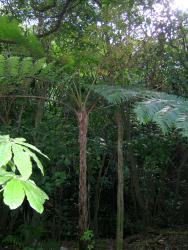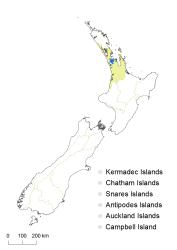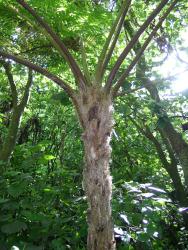- ≡ Alsophila cooperi Hook. ex F.Muell., Fragm. (Mueller) 5, 117 (1866)
- ≡ Sphaeropteris cooperi (Hook. ex F.Muell.) R.M.Tryon, Contr. Gray Herb. 200: 24 (1970)
Cyathea cooperi is similar to C. medullaris in having stipe scars on the trunk, and stipe scales with dark red, marginal setae that are lacking in all other New Zealand species of Cyathea. It differs in having pale or mid-brown stipes bearing pale brown scales, rather than the markedly black stipes and blackish-brown scales of C. medullaris. The tertiary pinnae of C. cooperi have more or less entire margins and rounded apices, compared to those in C. medullaris which are serrate and acute. The scales on the abaxial lamina surfaces are linear or acicular in outline, in contrast to the ovate scales of C. medullaris, although both species have scales with marginal setae. The sori of C. cooperi are distinctive in lacking indusia, but having setiferous scales around the base, quite unlike the indusia of C. medullaris that completely enclose the sori before maturity and then break open irregularly.
North Island: Auckland.
Known as a naturalised plant, with a trunk 500 mm high, only from Captain Springs Reserve, Auckland, but the species is cultivated in several places including the Bay of Islands, Auckland and Wellington.
Occurs naturally in Australia (eastern Queensland and New South Wales). It is naturalised in south-west Western Australia, and possibly in southern Victoria (Bostock 1998), and is a serious weed of rainforests in Hawai‘i (Palmer 2003).
Recorded from near water, under willow trees, probably as an escape from cultivation.
Gardner (1994). Voucher: AK 218773; CHR 484311, 1993.
A specimen collected by Mossman in 1850 from Wairoa, North Auckland (WELT P015834) belongs to this species. However, there must be some doubt as to whether it originated from a wild plant in New Zealand, or was a collection from Australia (where Mossman also visited) whose label was subsequently transposed. The species has been in cultivation in Auckland since about 1980 (Gardner 1994), and in Wellington since before 2006 (WELT P021977). Sporelings are known to have established in a nursery near Kerikeri, and the species has the potential to spread in Northland (Heenan et al. 1998).






